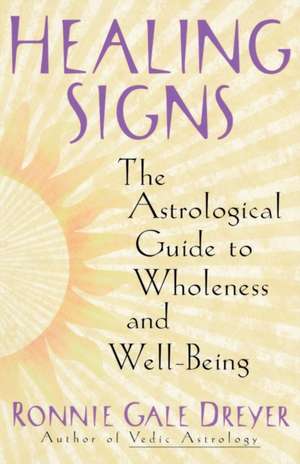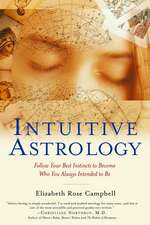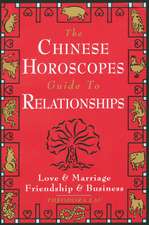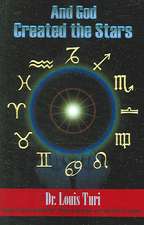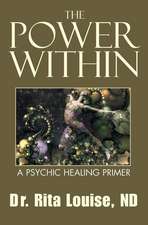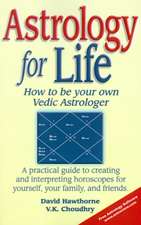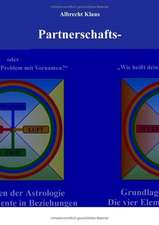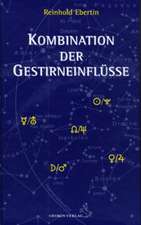Healing Signs: The Astrological Guide to Wholeness and Well Being
Autor Ronnie Gale Dreyeren Limba Engleză Paperback – 31 dec 1999
Have you ever wondered why one person seems prone to back and neck pain, while another is always suffering from colds and fevers--despite similar environments, work habits, and nutrition? The answer could be as simple as the day you were born. In Healing Signs, internationally recognized astrologer Ronnie Gale Dreyer explores why the planets affect the human body, and how, by understanding this relationship, one can experience a higher standard of health and well-being than ever before.
Perfect for the astrological novice and expert alike, Healing Signs outlines the fundamentals of astrology and explains why and how a person's sign profoundly affects not just personality and relationships, but also physical and mental health. Dreyer clearly describes the health concerns specific to each sign and then suggests the most effective alternative therapies, including exercise, diet, meditation, acupuncture, and aromatherapy. An appendix lists holistic health practitioners and products of interest.
People everywhere have long turned to astrology when their relationships needed mending; now Ronnie Gale Dreyer reveals how this ancient science can unlock the secrets to health and well-being.
Perfect for the astrological novice and expert alike, HEALING SIGNS outlines the fundamentals of astrology and explains why and how these building blocks profoundly affect not just personalities and relationships, but also physical and mental health. Dreyer clearly describes the health concerns specific to each sign and then suggests the most effective alternative therapies, including exercise, diet, meditation, acupuncture, and aromatherapy. An appendix lists holistic health practitioners and products of interest.
People everywhere have long turned to astrology when their relationships needed mending; now Ronnie Gale Dreyer reveals how this ancient science can unlock the secrets to health and well-being. -->
Preț: 115.10 lei
Nou
Puncte Express: 173
Preț estimativ în valută:
22.02€ • 23.06$ • 18.22£
22.02€ • 23.06$ • 18.22£
Carte disponibilă
Livrare economică 17-31 martie
Preluare comenzi: 021 569.72.76
Specificații
ISBN-13: 9780385498159
ISBN-10: 0385498152
Pagini: 336
Dimensiuni: 142 x 218 x 20 mm
Greutate: 0.42 kg
Editura: Main Street Books
ISBN-10: 0385498152
Pagini: 336
Dimensiuni: 142 x 218 x 20 mm
Greutate: 0.42 kg
Editura: Main Street Books
Notă biografică
Ronnie Gale Dreyer is an internationally known astrological consultant. She is the author of Vedic Astrology and Venus, as well as a series of guides to the sun signs. A popular lecturer and teacher, Dreyer has been on the faculty of astrology conferences around the world. She has studied Vedic Astrology at Sanskrit University in Benares, India. She lives in New York City.
Extras
How the Stars Affect Your Health
The Magical Moment of Birth: Your Personal Horoscope as Your Genetic Marker
If you took a snapshot of the sky at the moment you inhaled your very first breath, you would have a photograph of the Sun, Moon, and the eight planets* against a backdrop of the twelve constellations into which our galaxy is divided (as seen from the Earth). Known as the zodiacal belt or, more commonly, the twelve signs of the zodiac, these groupings were first cited and named by the ancient Babylonians, who viewed the heavens as a series of pictures the stars seemed to form. The first cluster of stars reminded them of a ram, which they named Aries, followed by other picturesque groups that they sequentially called Taurus the Bull, Gemini the Twins, Cancer the Crab, Leo the Lion, Virgo the Virgin, Libra the Scales, Scorpio the Scorpion, Sagittarius the Archer, Capricorn the Goat, Aquarius the Water Bearer, and Pisces the Fish (Fig. 1.1).
The Sun, Moon, and planets, which travel through the zodiacal belt, were worshiped by the ancients as celestial deities. Surrounded by the magnificent constellations, the ancient skies must have resembled a great stage where, night after night, the skirmishes and romances of their gods and goddesses were dramatized before their very eyes.
If you are fortunate enough to observe the sky on a clear evening with the aid of a telescope, or even with the naked eye, you can see the constellational shapes and sizes as distinctly as did the ancient Babylonians, Egyptians, Indians, Persians, and Greeks. Since the Sun is visible only during daylight hours, and the stars come out only at night, it is impossible to see the Sun against the backdrop of its constellation unless the sky is viewed at sunrise or sunset, when the Sun and the stars are equally visible. However, you will be able to see the Moon and some of the planets in their zodiacal signs most evenings. Of course, the time of year and your location will determine which planets can be viewed with the naked eye and which ones will need to be seen with the aid of a telescope.
Each planet's position in its zodiacal sign and its relationship to the other planets at the moment of birth form the basis of the horoscope. Derived from the Greek hora, meaning "hour," and scope, meaning "picture" or "vision," the horoscope is an image of the heavens at the exact time and place of birth and what astrologers believe spells out the story of your life.
Just as heredity defines much of who you are prior to conditioning by home, school, and society, astrology may be said to serve the same purpose. Since each planet represents a different aspect of human nature, the planets may be viewed as genetic markers which, based on their position and relationship to one another, predispose you to certain character traits, physical conditions, and, ultimately, illnesses.
This concept is supported by some scientists and astronomers, who theorize that at the moment of birth we are affected by the magnetic fields of the Earth and the Sun, which "are bound up with the positions and movements of the planets. It is as if the solar system--the Sun, Moon, and planets--is playing a complex symphony on the lines of force of the Earth's field."1 Most metaphysicians and "true believers" do not require scientific explanations; they firmly maintain that each planet symbolizes psychological and physical attributes, and the sign in which it is placed further modifies how it will be represented. Of course, you may say that it is asking too much to take something at face value without any proof. But once your disbelief is suspended, you may actually find astrology is not only rational but surprisingly accurate.
How Your Sign Determines General Vitality
Due to the proliferation of daily and monthly horoscope columns in newspapers and magazines, most people easily identify their Sun sign, that is, the zodiacal sign in which the Sun was placed on the day you were born as it made its annual journey through the twelve signs (Table 1.1).
Thus, if you were born on January 28, you would be considered an Aquarius since the Sun passes through the sign of Aquarius between January 20 and February 18. Going one step further, it is easy to see on which degree your Sun falls by simply advancing the date one degree per day. Since January 20 represents zero degrees of Aquarius, your Sun would be situated at 8 degrees Aquarius if you were born on January 28.
While the Moon, Mercury, and the remainder of the planets also fell in one of the signs on the day you were born, they may or may not have been positioned in the same sign as your Sun. Like the Sun, the planets are constantly on the move, albeit at different rates of speed and, therefore, their precise positions change daily. Whereas the Sun takes an entire year to travel through the twelve signs, or 360 degrees of the zodiac, the Moon takes only twenty-nine and a half days to make the same journey. If, for example, you are an Aquarius, yet have three other planets in Capricorn, you may actually have more Capricornian characteristics than those of an Aquarius.**
Keywords of the Signs and Planets
Table 1.2 conveys the keywords of each planet and sign. If your Sun, which represents basic vitality, health, and personality, is placed in Capricorn, you will more than likely be disciplined, structured, and calculating in your climb to the top. If your Moon is in that sign, your emotions, colored by Capricornian traits, will be reserved. Mercury in Capricorn endows a disciplined mind and reticent speech. Venus in Capricorn suggests you are loyal and dependable in love but tend to withhold feelings, while Mars in Capricorn bestows ambition and a tendency toward workaholism, which will help you ascend the ladder of success. Very simply stated, you apply the attributes of a particular sign to qualities represented by the occupying planet. If several planets in your chart inhabit a sign other than that of your Sun, you may find that you identify more with that sign's description. If this is the case, the delineation for both your Sun sign and the sign representing the other planets may apply.
* Because we view the movements of the luminaries from the perspective of being on Earth, the eight planets are Mercury, Venus, Mars, Jupiter, Saturn, Uranus, Neptune, and Pluto. For astrological purposes, the Sun and Moon, known to the ancients as the "lights," are also regarded as planets.
** An ephemeris, which can be obtained in most bookstores, lists the daily positions of the planets in their zodiacal signs. If you would like a more precise horoscope, which includes the precise sign and degree of your ascendant and the planets, and do not own an astrological software program, the Appendix lists where you can obtain a copy of your horoscope either by mail order or on the web.
The Magical Moment of Birth: Your Personal Horoscope as Your Genetic Marker
If you took a snapshot of the sky at the moment you inhaled your very first breath, you would have a photograph of the Sun, Moon, and the eight planets* against a backdrop of the twelve constellations into which our galaxy is divided (as seen from the Earth). Known as the zodiacal belt or, more commonly, the twelve signs of the zodiac, these groupings were first cited and named by the ancient Babylonians, who viewed the heavens as a series of pictures the stars seemed to form. The first cluster of stars reminded them of a ram, which they named Aries, followed by other picturesque groups that they sequentially called Taurus the Bull, Gemini the Twins, Cancer the Crab, Leo the Lion, Virgo the Virgin, Libra the Scales, Scorpio the Scorpion, Sagittarius the Archer, Capricorn the Goat, Aquarius the Water Bearer, and Pisces the Fish (Fig. 1.1).
The Sun, Moon, and planets, which travel through the zodiacal belt, were worshiped by the ancients as celestial deities. Surrounded by the magnificent constellations, the ancient skies must have resembled a great stage where, night after night, the skirmishes and romances of their gods and goddesses were dramatized before their very eyes.
If you are fortunate enough to observe the sky on a clear evening with the aid of a telescope, or even with the naked eye, you can see the constellational shapes and sizes as distinctly as did the ancient Babylonians, Egyptians, Indians, Persians, and Greeks. Since the Sun is visible only during daylight hours, and the stars come out only at night, it is impossible to see the Sun against the backdrop of its constellation unless the sky is viewed at sunrise or sunset, when the Sun and the stars are equally visible. However, you will be able to see the Moon and some of the planets in their zodiacal signs most evenings. Of course, the time of year and your location will determine which planets can be viewed with the naked eye and which ones will need to be seen with the aid of a telescope.
Each planet's position in its zodiacal sign and its relationship to the other planets at the moment of birth form the basis of the horoscope. Derived from the Greek hora, meaning "hour," and scope, meaning "picture" or "vision," the horoscope is an image of the heavens at the exact time and place of birth and what astrologers believe spells out the story of your life.
Just as heredity defines much of who you are prior to conditioning by home, school, and society, astrology may be said to serve the same purpose. Since each planet represents a different aspect of human nature, the planets may be viewed as genetic markers which, based on their position and relationship to one another, predispose you to certain character traits, physical conditions, and, ultimately, illnesses.
This concept is supported by some scientists and astronomers, who theorize that at the moment of birth we are affected by the magnetic fields of the Earth and the Sun, which "are bound up with the positions and movements of the planets. It is as if the solar system--the Sun, Moon, and planets--is playing a complex symphony on the lines of force of the Earth's field."1 Most metaphysicians and "true believers" do not require scientific explanations; they firmly maintain that each planet symbolizes psychological and physical attributes, and the sign in which it is placed further modifies how it will be represented. Of course, you may say that it is asking too much to take something at face value without any proof. But once your disbelief is suspended, you may actually find astrology is not only rational but surprisingly accurate.
How Your Sign Determines General Vitality
Due to the proliferation of daily and monthly horoscope columns in newspapers and magazines, most people easily identify their Sun sign, that is, the zodiacal sign in which the Sun was placed on the day you were born as it made its annual journey through the twelve signs (Table 1.1).
Thus, if you were born on January 28, you would be considered an Aquarius since the Sun passes through the sign of Aquarius between January 20 and February 18. Going one step further, it is easy to see on which degree your Sun falls by simply advancing the date one degree per day. Since January 20 represents zero degrees of Aquarius, your Sun would be situated at 8 degrees Aquarius if you were born on January 28.
While the Moon, Mercury, and the remainder of the planets also fell in one of the signs on the day you were born, they may or may not have been positioned in the same sign as your Sun. Like the Sun, the planets are constantly on the move, albeit at different rates of speed and, therefore, their precise positions change daily. Whereas the Sun takes an entire year to travel through the twelve signs, or 360 degrees of the zodiac, the Moon takes only twenty-nine and a half days to make the same journey. If, for example, you are an Aquarius, yet have three other planets in Capricorn, you may actually have more Capricornian characteristics than those of an Aquarius.**
Keywords of the Signs and Planets
Table 1.2 conveys the keywords of each planet and sign. If your Sun, which represents basic vitality, health, and personality, is placed in Capricorn, you will more than likely be disciplined, structured, and calculating in your climb to the top. If your Moon is in that sign, your emotions, colored by Capricornian traits, will be reserved. Mercury in Capricorn endows a disciplined mind and reticent speech. Venus in Capricorn suggests you are loyal and dependable in love but tend to withhold feelings, while Mars in Capricorn bestows ambition and a tendency toward workaholism, which will help you ascend the ladder of success. Very simply stated, you apply the attributes of a particular sign to qualities represented by the occupying planet. If several planets in your chart inhabit a sign other than that of your Sun, you may find that you identify more with that sign's description. If this is the case, the delineation for both your Sun sign and the sign representing the other planets may apply.
* Because we view the movements of the luminaries from the perspective of being on Earth, the eight planets are Mercury, Venus, Mars, Jupiter, Saturn, Uranus, Neptune, and Pluto. For astrological purposes, the Sun and Moon, known to the ancients as the "lights," are also regarded as planets.
** An ephemeris, which can be obtained in most bookstores, lists the daily positions of the planets in their zodiacal signs. If you would like a more precise horoscope, which includes the precise sign and degree of your ascendant and the planets, and do not own an astrological software program, the Appendix lists where you can obtain a copy of your horoscope either by mail order or on the web.
Descriere
"Healing Signs" does for health what Linda Goodman's bestselling "Love Signs" did for relationships, showing how this ancient science can unlock the secrets to health and well-being.
